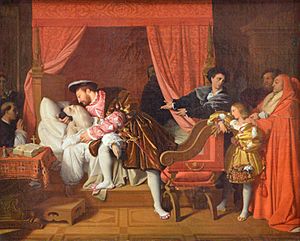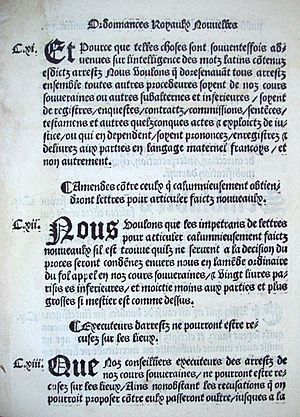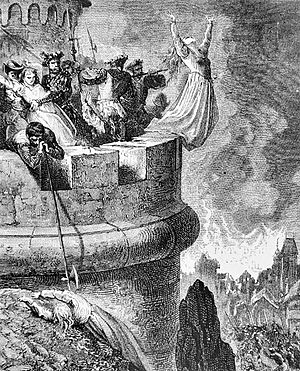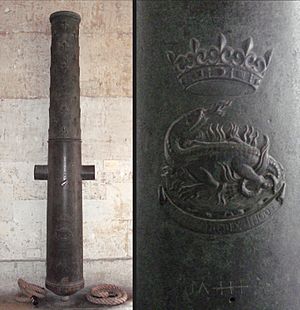Francis I of France facts for kids
Quick facts for kids Francis I |
|
|---|---|
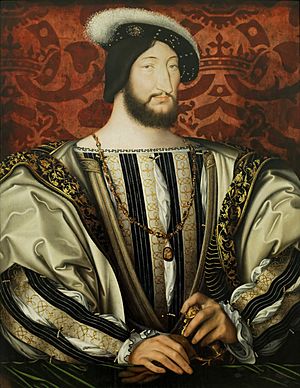
Portrait by Jean Clouet, c. 1530
|
|
| King of France (more...) | |
| Reign | 1 January 1515 – 31 March 1547 |
| Coronation | 25 January 1515 |
| Predecessor | Louis XII |
| Successor | Henry II |
| Duke of Milan | |
| Reign | 11 October 1515 – 20 November 1521 |
| Predecessor | Massimiliano Sforza |
| Successor | Francesco II Sforza |
| Born | 12 September 1494 Château de Cognac, Cognac, France |
| Died | 31 March 1547 (aged 52) Château de Rambouillet, France |
| Burial | 23 May 1547 Basilica of St Denis, France |
| Spouse |
|
| Issue among others... |
Francis III, Duke of Brittany Henry II of France Madeleine, Queen of Scots Charles, Duke of Orléans Margaret, Duchess of Savoy |
| House | Valois-Angoulême |
| Father | Charles, Count of Angoulême |
| Mother | Louise of Savoy |
| Religion | Catholicism |
| Signature | 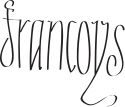 |
Francis I (born 12 September 1494 – died 31 March 1547) was the King of France from 1515 until his death. He was the son of Charles, Count of Angoulême, and Louise of Savoy. He became king after his cousin and father-in-law, Louis XII, passed away without a son.
Francis was a huge supporter of the arts. He helped the French Renaissance grow by inviting many Italian artists to work for him. One famous artist was Leonardo da Vinci, who brought the Mona Lisa to France. During Francis's rule, France saw big changes. The king's power grew, and new ideas like humanism and Protestantism spread. French explorers also began to explore the New World. Explorers like Jacques Cartier claimed lands in the Americas for France. This started the first French colonial empire.
He was known as the 'Father and Restorer of Letters' because he helped develop the French language. People also called him 'Francis of the Large Nose' and the 'Knight-King'. Francis continued the Italian Wars, just like the kings before him. His main rival was Emperor Charles V. Charles ruled many lands, including Spain and the Netherlands. This meant France was surrounded by Charles's empire. Francis tried to get help from Henry VIII of England at the Field of the Cloth of Gold. When that didn't work, he made an alliance with the Muslim sultan Suleiman the Magnificent. This was a very unusual move for a Christian king at the time.
Contents
Becoming King: Francis's Early Life
Francis of Orléans was born on 12 September 1494. His birthplace was the Château de Cognac in the town of Cognac, France. At that time, Cognac was part of the province of County of Saintonge.
Francis was the only son of Charles of Orléans, Count of Angoulême, and Louise of Savoy. He was also a great-great-grandson of King Charles V of France. His family did not expect him to become king. This was because King Charles VIII was young when Francis was born. Also, his father's cousin, the Duke of Orléans (who later became King Louis XII), was also young.
However, Charles VIII died in 1498 without any children. Louis XII then became king, but he also had no sons. French law, called the Salic Law, stopped women from inheriting the throne. So, when Francis was four years old, he became the next in line to the French throne. He was given the title of Duke of Valois.
In 1505, King Louis XII became ill. He ordered that his daughter Claude and Francis should marry right away. But they only became engaged after a meeting of nobles. Claude was the heir to the Duchy of Brittany through her mother, Anne of Brittany. After Anne's death, Francis and Claude married on 18 May 1514. On 1 January 1515, Louis XII died. Francis then became King of France. He was crowned king in the Cathedral of Reims on 25 January 1515. Claude became his queen.
Francis's Time as King
When Francis was growing up, new ideas from the Italian Renaissance were becoming popular in France. Some of his teachers were interested in these new ways of thinking. They tried to share these ideas with Francis. He studied many subjects like math, geography, history, and languages. He learned Hebrew, Italian, Latin, and Spanish. Francis also enjoyed chivalry, dancing, and music. He loved sports like archery, hunting, and jousting. He also read philosophy and theology. He was very interested in art, literature, poetry, and science. His mother loved Italian Renaissance art, and she passed this interest on to him. Francis was more influenced by humanism than any French king before him.
Supporting the Arts
By the time Francis became king in 1515, the Renaissance had fully arrived in France. Francis became a huge supporter of artists. When he became king, French palaces had only a few paintings and no sculptures.
Francis supported many great artists of his time. This included Andrea del Sarto and Leonardo da Vinci. Leonardo da Vinci was convinced to live in France during his last years. He painted very little in France, but he brought many of his best works with him. These included the Mona Lisa, which stayed in France after his death. Other important artists Francis supported were Benvenuto Cellini, Rosso Fiorentino, Giulio Romano, and Primaticcio. They all helped decorate Francis's palaces. He also hired people in Italy to find famous artworks and send them to France.
A King Who Loved Books
Francis was also known as a man of letters. He supported many important writers of his time. He was also a poet himself. Francis worked hard to improve the royal library. He made the great French humanist Guillaume Budé the chief librarian. He also started to make the collection bigger. Francis hired people in Italy to look for rare books and old writings. Just like with art, he wanted to bring the best books to France. During his rule, the library grew much larger. He also read the books he bought, which was rare for a king. Francis made an important decision to open his library to scholars from all over the world. This helped spread knowledge.
In 1537, Francis signed an order called the Ordonnance de Montpellier. This law said that his library must get a copy of every book sold in France. Francis's older sister, Marguerite, was also a talented writer. She wrote a famous collection of short stories called the Heptameron. Francis also wrote letters to the philosopher Claude de Bectoz. He liked her letters so much that he carried them around and showed them to the ladies at his court.
Building Grand Palaces
Francis spent a lot of money on new buildings. He continued work on the Château d'Amboise and started fixing up the Château de Blois. Early in his rule, he began building the amazing Château de Chambord. This castle was inspired by Italian Renaissance architecture. Some even think Leonardo da Vinci might have designed parts of it. Francis also rebuilt the Louvre Palace. He changed it from a medieval fort into a beautiful Renaissance building. He paid for a new City Hall in Paris, called the Hôtel de Ville. He also built the Château de Madrid and rebuilt the Château de Saint-Germain-en-Laye.
His biggest building project was making the Château de Fontainebleau much larger and grander. This quickly became his favorite home. All of Francis's buildings were decorated beautifully, inside and out. For example, at Fontainebleau, there was a fountain in the courtyard that mixed wine with water.
Military Actions and Rivalries
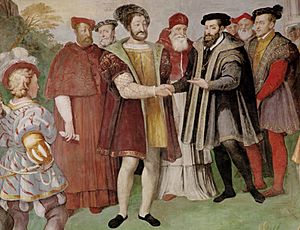
The Italian Wars (1494–1559) were a big part of Francis I's rule. But these wars were not his only focus. Francis simply continued the wars that earlier kings had started. His successors would also continue them after his death. The wars began when Milan asked King Charles VIII of France for help against the King of Naples. Francis's military and diplomatic efforts had both successes and failures.
Francis tried but failed to become Holy Roman Emperor in 1519. However, he had some victories. For example, in 1515, Francis won a big battle at Marignano. This victory allowed him to capture the Italian city of Milan. But later, in 1521, he had to give up Milan.
Much of Francis's military actions focused on his enemy, Charles V. Francis and Charles had a strong personal rivalry. Charles even challenged Francis to a one-on-one fight many times. Besides the Holy Roman Empire, Charles also ruled Spain, Austria, and other lands near France. This made him a constant threat to Francis's kingdom.
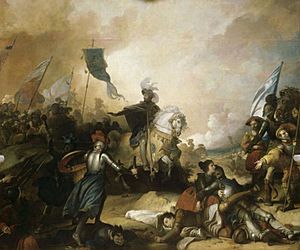
Francis tried to make an alliance with Henry VIII of England. They met at the famous Field of Cloth of Gold in 1520. They spent two weeks in lavish meetings, but they could not agree on an alliance. Francis and Henry both wanted power and glory. Their relationship was full of rivalry. Francis wanted to take back Milan, and Henry wanted to recapture northern France.
Francis suffered his worst defeat at the Battle of Pavia in 1525. He was actually taken prisoner during this battle. Francis was held captive in Madrid. He wrote a famous letter to his mother, saying, "Of all things, nothing remains to me but honour and life, which is safe." This is often remembered as "All is lost save honour."
Francis had to make big promises to Charles V in the Treaty of Madrid (1526). He gave up claims to Naples and Milan in Italy. He also agreed that the Duchy of Burgundy was independent. Finally, Francis was engaged to Charles's sister, Eleanor. Francis was allowed to go back to France in exchange for his two sons, Francis and Henry, as hostages. But once he was free, he said that his agreement with Charles was made under force. He refused to follow the treaty. A new alliance with England helped Francis reject the Madrid treaty.
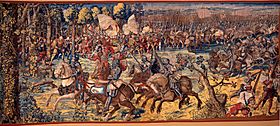
Francis continued his dislike of Charles V and his wish to control Italy. In the mid-1520s, Pope Clement VII wanted to free Italy from foreign control. So, he allied with Venice to form the League of Cognac. Francis joined this League in 1526. But Francis's allies were not strong, and the war ended with the Treaty of Cambrai in 1529. This treaty was called "the Peace of the Ladies" because Francis’s mother and Charles’s aunt negotiated it. Francis's two sons were released, and Francis married Eleanor.
After the League of Cognac failed, Francis made a secret alliance with the Landgrave of Hesse in 1534. This was against Charles V. Francis also got help from the Ottoman Empire. After the ruler of Milan died, Francis started fighting in Italy again in 1536. This fighting ended with the Truce of Nice. But this agreement also broke down. This led to Francis's last attempt to control Italy in the Italian War of 1542–1546. This time, Francis managed to hold off Charles V and Henry VIII. Charles V had to sign the Treaty of Crépy because he had money problems and other conflicts.
Exploring New Worlds and Asia
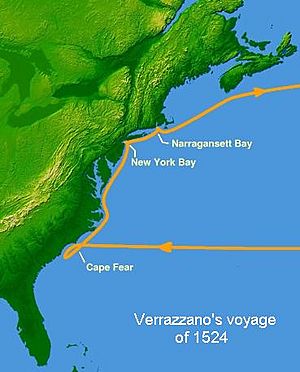
Francis was unhappy about a papal law that gave Portugal control over Africa and the Indies. He famously said, "The sun shines for me as it does for others. I would very much like to see the clause of Adam’s will by which I should be denied my share of the world."
To balance the power of Charles V's empire, Francis wanted to connect with the New World and Asia. He sent ships to the Americas and the Far East. He also built close ties with the Ottoman Empire. This helped French trade in the Mediterranean Sea and created a military alliance.
The port city now called Le Havre was founded in 1517 during Francis's early rule. A new port was needed because older harbors were becoming too shallow. Le Havre was first named Franciscopolis after the king, but this name did not last.
Americas
In 1524, Francis helped fund an expedition by Giovanni da Verrazzano to North America. Verrazzano visited the area that is now New York City. He named it New Angoulême. He also claimed Newfoundland for France.
In 1534, Francis sent Jacques Cartier to explore the St. Lawrence River in Quebec. Cartier was looking for "certain islands and lands where it is said there must be great quantities of gold and other riches." In 1541, Francis sent Jean-François de Roberval to settle Canada. He also wanted him to spread the "Holy Catholic faith."
Far East Asia
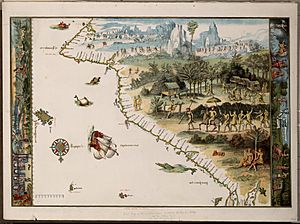
French trade with East Asia began during Francis I's reign. In 1527, a French trading ship from Rouen arrived in the Indian city of Diu. In 1529, Jean Parmentier reached Sumatra. This expedition led to the creation of the Dieppe maps.
Ottoman Empire
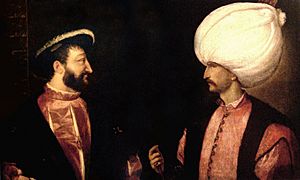
Under Francis I, France was the first European country to have official relations with the Ottoman Empire. Francis made an alliance with the Ottoman Empire. His goal was to find an ally against the House of Habsburg (Charles V). Francis said he wanted to protect Christians in Ottoman lands. This alliance was very unusual for a Christian king. It was called "the impious alliance." But it lasted many years because it helped both sides. The two powers worked together against Charles V. In 1543, they even joined forces for a naval attack in the Siege of Nice.
In 1533, Francis I sent an ambassador to Morocco. This started official relations between France and Morocco. The ruler of Fez welcomed the French. He allowed French traders to ship goods freely and protected them.
Changes in Government and Language
Francis took steps to end the use of Latin as the only language for knowledge. In 1530, he declared French the national language. That same year, he opened the Collège des trois langues, or Collège Royal. Students there could study Greek, Hebrew, and Aramaic. Later, Arabic was added.
In 1539, Francis signed an important law called the Ordinance of Villers-Cotterêts. This law made French the official language for government documents. It replaced Latin. This same law also required priests to record births, marriages, and deaths. They had to set up a registry office in every parish. This was the first time such detailed records were kept in Europe.
Religious Policies
During Francis's reign, there were big divisions in Christianity in Western Europe. Martin Luther's teachings started the Protestant Reformation. This movement spread across much of Europe, including France.
At first, Francis was somewhat open to the new Protestant ideas. He was influenced by his sister, Marguerite de Navarre, who was interested in Luther's ideas. Francis even thought it might be useful politically. It caused some German princes to turn against his enemy, Charles V.
However, Francis's attitude towards Protestantism changed. This happened after the "Affair of the Placards" on 17 October 1534. On this night, notices appeared in Paris and other cities. These notices spoke out against the Catholic mass. Many Catholics were very angry about these notices. Francis himself began to see the Protestant movement as a threat to his rule. He started to persecute its followers. Protestants were put in jail and executed. In some areas, entire villages were destroyed. In Paris, after 1540, Francis had people like Étienne Dolet executed for their beliefs. Printing was controlled, and leading Protestant reformers like John Calvin had to leave the country. These persecutions led to many deaths and forced many people from their homes.
Persecutions against Protestants were made official in the Edict of Fontainebleau (1540). This was a law issued by Francis. Major acts of violence continued. For example, Francis ordered the execution of the Waldensians at the Massacre of Mérindol in 1545.
Death of the King
Francis died at the Château de Rambouillet on 31 March 1547. This was on his son and successor's 28th birthday. It is said that he "died complaining about the weight of a crown." He was buried with his first wife, Claude, in Saint Denis Basilica. His son, Henry II, became the next king.
Francis's tomb and those of his wife and mother were damaged on 20 October 1793. This happened during the Reign of Terror in the French Revolution.
Francis's Image and Legacy
Francis I has sometimes had a mixed reputation in France. His 500th anniversary in 1994 was not widely celebrated. People often forget his beautiful castles, amazing art collection, and his support for scholars and artists. He is sometimes seen as a king who was defeated and captured at Pavia.
Francis's personal symbol was the salamander. His Latin motto was Nutrisco et extinguo, meaning "I nourish [the good] and extinguish [the bad]." Because of his long nose, he was nicknamed 'Francis of the Big Nose'. He was also known as the 'Knight-King' because he often fought in battles himself.
British historian Glenn Richardson sees Francis as a successful king. He says Francis was a king who truly ruled. He understood the importance of war and being known internationally. In battle, he was brave, though sometimes too eager. At home, Francis used his royal power fully. He was good at getting what he wanted regarding taxes and other issues. He made the king's power stronger and kept decision-making close to himself. But he also used gifts and his own charm to build loyalty among the nobles. Under Francis, the French court was very important and influential in the 16th century. Even though opinions have changed over time, his cultural gifts to France and its Renaissance were huge. This should secure his place as one of France's greatest kings.
Marriage and Children
On 18 May 1514, Francis married his cousin Claude. She was the daughter of King Louis XII of France and Duchess Anne of Brittany. Francis and Claude had seven children:
- Louise (born 1515 – died 1518): She died young.
- Charlotte (born 1516 – died 1524): She also died young.
- Francis (born 1518 – died 1536): He became Duke of Brittany after his mother. He died at age 18.
- Henry II (born 1519 – died 1559): He became King of France after his father. He married Catherine de' Medici and had children.
- Madeleine (born 1520 – died 1537): She married James V of Scotland but had no children.
- Charles (born 1522 – died 1545): He died without marrying or having children.
- Margaret (born 1523 – died 1574): She married Emmanuel Philibert, Duke of Savoy in 1559 and had children.
On 7 July 1530, Francis I married his second wife, Eleanor of Austria. She was the sister of Emperor Charles V. They did not have any children together.
Francis I in Stories and Movies
Francis I has been a character in many stories, plays, and movies. His life inspired the 1832 play Francis the First. He also appears in Victor Hugo's play Le Roi s'amuse ("The King's Amusement"). This play later became the famous opera Rigoletto by Giuseppe Verdi.
Many actors have played Francis I in films. These include William Powell (1922), Sacha Guitry (1937), Jean Marais (1955), and Timothy West (1998). He is also mentioned in novels about Mary Boleyn and Anne Boleyn, who both spent time at his court. Francis appears in Hilary Mantel's novel Wolf Hall. He is also a main character in the 1998 movie Ever After, a modern version of the Cinderella story. In that movie, Leonardo da Vinci arrives at his court with the Mona Lisa.
Images for kids
See also
 In Spanish: Francisco I de Francia para niños
In Spanish: Francisco I de Francia para niños
- Castell del Patriarca
- Franco-Ottoman alliance



